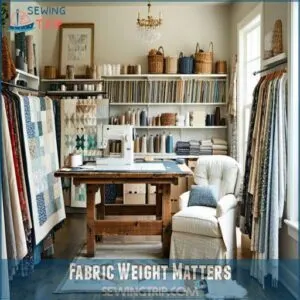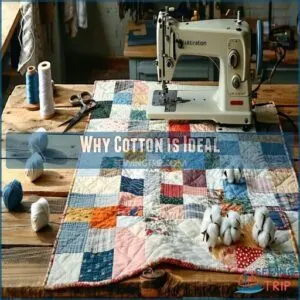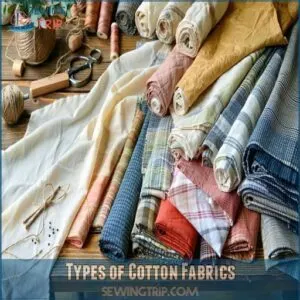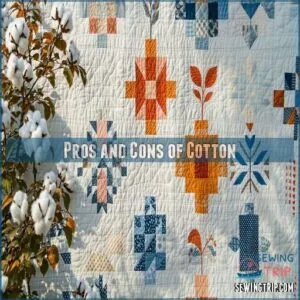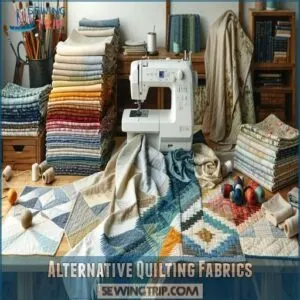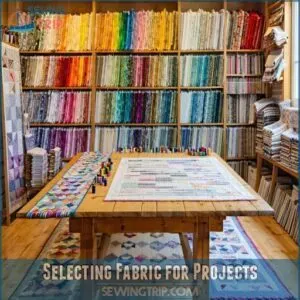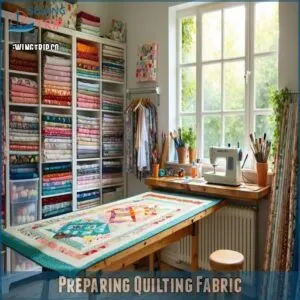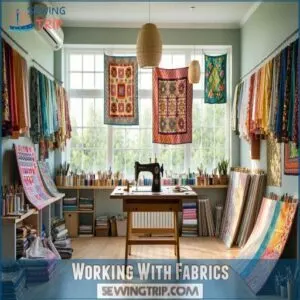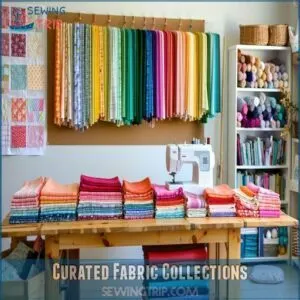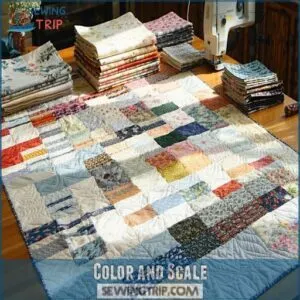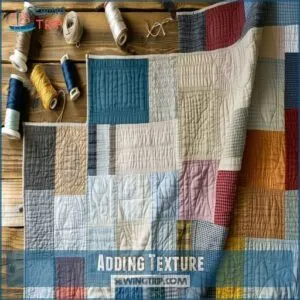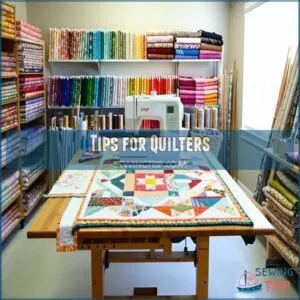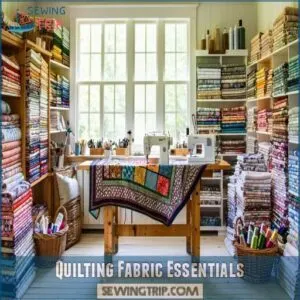This site is supported by our readers. We may earn a commission, at no cost to you, if you purchase through links.
 When hunting for the best fabric for quilting projects, quilting cotton is your trusty sidekick. Its tight weave and high thread count make stitching smoother than butter on a hot skillet. You’ll love how it minimizes shrinkage and holds up to countless washes.
When hunting for the best fabric for quilting projects, quilting cotton is your trusty sidekick. Its tight weave and high thread count make stitching smoother than butter on a hot skillet. You’ll love how it minimizes shrinkage and holds up to countless washes.
But don’t stop there! Flannel adds cozy charm, while gauze brings lightweight breathability. If you’re craving luxury, minky’s cloud-soft texture will make your quilt irresistible.
Pro tip: always prewash to prevent color bleeding and keep those crisp edges looking sharp. Mix solids and prints, throw in a zinger fabric, and you’ll create a quilt that’ll have everyone saying, "Wow, you made that?
Table Of Contents
Key Takeaways
- You’ll want to choose 100% quilting cotton as your primary fabric, focusing on tight weaves, high thread counts, and prewashing to prevent shrinkage and color bleeding.
- Don’t limit yourself to just one fabric type – explore alternative textures like flannel, minky, and gauze to add depth, softness, and unique character to your quilting projects.
- You’ll create more professional-looking quilts by understanding fabric collections, color theory, and mixing print scales – use a strategic approach to selecting complementary fabrics.
- Consider your project’s specific purpose when selecting fabrics, matching the material’s weight, durability, and texture to whether you’re making a baby quilt, wall hanging, or bed cover.
Choosing Quilting Fabric
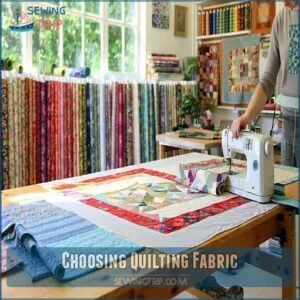
You’re about to begin a fabric-choosing adventure that’ll transform your quilting game from basic to brilliant!
Whether you’re a newbie or a seasoned stitcher, understanding the magic of selecting the perfect fabric is your secret weapon for creating quilts that’ll make other crafters green with envy.
Quilting Cotton
Quilting cotton is the go-to fabric for quilters, a true rockstar in the crafting world. Its tight weave and durability make it the perfect canvas for creating masterpieces.
With a high thread count, quilting cotton ensures smoother stitching, and pre-washing prevents unwanted shrinkage or color bleeding later on.
Whether you’re a beginner or an experienced quilter, this versatile fabric is an excellent choice for your projects.
Flannel
Almost every quilter has a soft spot for flannel’s cozy charm. When you’re ready to create a quilt that feels like a warm hug, flannel becomes your go-to fabric.
Here’s why it rocks:
- Incredible softness that screams comfort
- Perfect for rag quilts and winter designs
- Available in countless patterns and colors
- Adds luxurious texture to your quilting projects
Prewash carefully to prevent unexpected shrinkage and enjoy its snuggly magic.
Gauze
Seasoned quilters should know that gauze is a secret weapon for creating lightweight, breathable quilts that whisper softness.
Its open-weave structure gives projects an airy, delicate touch. This makes it perfect for summer blankets or baby wraps.
Pre-wash gauze carefully to prevent shrinkage and embrace this versatile quilting fabric. It adds ethereal charm to your creative masterpieces.
Minky
Minky bursts onto the quilting scene with cuddle-worthy charm, sliding from gauzy lightness. This plush fabric transforms ordinary projects into luxurious sensory experiences.
Wondering how to rock Minky in your next quilt? Check out these pro tips:
- Choose ultra-soft Minky for baby blankets and cozy throws
- Select weight and pile carefully
- Pair with cotton for stability
- Embrace its dreamy, cloud-like texture
Cotton Canvas
Cotton canvas is more than just a tough guy in the quilting world; this heavyweight material brings serious durability to your Canvas projects, right in the thick of it.
Perfect for outdoor gear, home decor, and quilts that need to withstand real-world wear, it offers a strong alternative to traditional quilting cotton.
When selecting fabrics, considering the best fabric options is important for achieving the desired outcome. Ready to level up your quilting game?
Fabric Weight Matters
Ever wondered why some quilts feel like a dream while others feel like a lead blanket? It’s all about fabric weight – measured in GSM (grams per square meter). Your quilting fabric’s weight can make or break your project’s comfort and look.
Consider these game-changing insights:
- Feel the difference between a lightweight summer quilt and a cozy winter wrap
- Discover how fabric weight impacts your quilt’s drape and overall personality
- Learn to choose weights that’ll make your quilting projects sing
Understanding fabric handling techniques is important for a successful project.
Master the art of GSM, and you’ll discover quilting magic that’ll have everyone talking.
Cotton for Quilting
You’ve probably heard quilters rave about cotton, and for good reason – it’s the superhero of quilting fabrics.
With its incredible durability, vibrant colors, and soft texture, cotton will transform your quilting project from ordinary to extraordinary, making every stitch a joy to create.
Why Cotton is Ideal
After weighing fabric options, cotton emerges as the quilting champion you’ll want in your corner. Its breathability and durability make it a top-tier choice for crafting stunning quilts that stand the test of time.
Check out how cotton stacks up:
| Property | Beginner | Intermediate | Expert |
|---|---|---|---|
| Durability | Good | Better | Best |
| Softness | Smooth | Softer | Luxurious |
| Color Retention | Solid | Vibrant | Outstanding |
| Ease of Use | Simple | Versatile | Masterful |
| Shrinkage | Minimal | Predictable | Controllable |
Working with best quilting cotton is essential for achieving professional results. Quilting cotton isn’t just fabric—it’s your creative canvas waiting to tell a story.
Types of Cotton Fabrics
Now that you understand why cotton rocks for quilting, let’s explore its fabric types.
Not all cotton is created equal! You’ll find a rainbow of weave variations, from tightly woven quilting cottons with high thread counts to more relaxed, breathable options.
Different dyeing processes and finishing techniques mean you can snag cotton fabrics that range from crisp and smooth to soft and textured – perfect for bringing your quilting vision to life.
Pros and Cons of Cotton
Cotton’s breathability is a game-changer, letting your quilt breathe like a second skin.
Its durability makes it a quilter’s best friend, standing up to wash after wash. Watch out for shrinkage concerns, though – pre-washing is your secret weapon.
With excellent colorfastness and reasonable cost, quilting cotton remains the champion of fabric choices.
Alternative Quilting Fabrics
Ready to break free from traditional quilting cotton and explore a world of exciting fabric alternatives?
You’ll discover how flannel, linen, silk, wool, and synthetic fabrics can transform your quilting projects from ordinary to extraordinary, giving you the creative freedom to craft truly unique and stunning quilts.
Flannel Options
Immerse yourself in the cozy world of flannel and transform your quilting game. Flannel brings a warmth and softness that’ll make your quilts irresistible.
Check out these flannel must-knows:
- Explore flannel weights from lightweight to heavyweight
- Discover rich color palettes and playful prints
- Master pre-washing techniques for perfect fabric preparation
Your quilting adventure just got cozier with fabric magic!
Linen Choices
Some quilters swear by linen’s unique charm when exploring quilting fabric types. Its crisp texture and beautiful drape make it a versatile choice for adventurous projects.
Linen, while heavier than cotton, offers a rustic elegance that breathes and softens with each wash. Pre-washing is essential to prevent shrinkage and guarantee your quilting fabric maintains its character through countless cozy creations.
Understanding linen preparation is important for working with this natural fiber to achieve the best results.
Silk Considerations
When silk whispers luxury into your quilting dreams, tread carefully. Delicate silk quilting fabric demands gentle handling and specific techniques.
Lightweight silk types work best for wall hangings or decorative pieces, while heavier weights can create stunning texture.
Prewashing is essential to prevent shrinkage, and consider silk alternatives if you’re worried about maintenance and durability.
Wool Alternatives
Wool’s warmth meets its match in alternative batting options!
Bamboo batting brings eco-friendly softness that’ll make your quilts sing.
Cotton batting remains a classic choice for breathability and comfort.
Polyester batting offers lightweight warmth and durability, giving you flexibility to create quilts that balance texture, drape, and cozy performance without breaking the bank.
Synthetic Fabrics
After exploring wool’s cozy charm, synthetic fabrics burst onto the quilting scene with their own superpowers.
Polyester brings durability and wrinkle resistance, while rayon offers silky resilience.
Acrylic adds vibrant color options, and nylon provides tough outdoor quilting performance.
Microfiber‘s incredible softness rivals minky, making these fabrics perfect for fleece-like comfort and innovative quilting projects that demand versatility.
Selecting Fabric for Projects
When you’re ready to start your next quilting project, the fabric you choose can make or break your masterpiece.
Your success depends on understanding how project type, fabric weave, color, and potential shrinkage will impact your final creation.
Project Type and Purpose
When choosing fabric, your project’s purpose is your North Star. The right material makes all the difference, whether you’re crafting a snuggly baby quilt or a statement wall hanging. Quilting isn’t just sewing – it’s storytelling through texture and design.
- Bed quilts demand warmth and durability
- Baby quilts require softness next to delicate skin
- Wall hangings showcase intricate design and color
- Clothing pieces need flexibility and comfort
Fabric Weave and Texture
Explore fabric weave and texture, where your quilting magic truly comes alive! Different weave types create unique tactile properties that can make or break your project.
Cotton quilting fabric offers a smooth, tight weave that’s a quilter’s dream.
Linen brings a delightful textured charm that adds depth and character to your masterpiece.
Color and Pattern
Your quilt’s color story begins with a strategic eye for design. Embrace color psychology by mixing patterns that dance together – think small blenders nestled alongside bold, vibrant prints.
Play with thematic palettes that create visual depth, using contrasting colors to make your fabric design pop. Understanding quilt patterns is essential for selecting the right fabrics and creating a harmonious quilt.
Fabric collections become your secret weapon for creating harmonious, eye-catching quilts that tell a unique story.
Fabric Shrinkage
Picking patterns can be a blast, but fabric shrinkage can turn your quilting dream into a sizing nightmare.
Preshrinking techniques are your secret weapon. Wash fabrics before cutting to prevent unwelcome surprises.
Pro quilters know calculating shrinkage saves heartache later. Prewash similar fabrics together, use warm water, and let them air dry to keep your quilt looking sharp and true to design.
Preparing Quilting Fabric
Before you start quilting, you’ll want to roll up your sleeves and get your fabric ready because preparation is half the battle in creating a stunning quilt.
Master the art of washing, ironing, cutting, and storing your fabrics.
You’ll set yourself up for quilting success that’ll make even seasoned crafters nod in approval.
Washing and Drying
After carefully selecting fabrics for your quilt project, prewashing becomes your secret weapon.
Different fabric types demand specific care, so check labels before tossing them in the wash. Use warm water and mild detergents designed for quilting fabrics.
Separate colors to prevent bleeding, and opt for gentle cycles.
Air-drying or low-heat tumble drying helps maintain fabric integrity, ensuring your quilting masterpiece stays crisp and vibrant from start to finish.
Ironing and Pressing
Ironing and pressing are your secret weapons, from washing to perfecting your fabric’s crispness. Set your iron temperature just right to avoid fabric distortion.
Fabric care matters! Gentle pressing – not dragging – keeps seam allowances precise.
Pro quilters tap into pressing techniques that make fabric sing. Lift and press, don’t slide, to prevent wrinkles and maintain your quilt’s professional finish.
Cutting and Storing
Level up your quilting game by nailing your cutting and storing techniques. A high-quality self-healing cutting mat, sharp rotary cutter, and clear acrylic ruler are your best friends for precision.
Store fabrics smartly—avoid direct sunlight, use acid-free tissue paper, and fold carefully to prevent creases. Control humidity and treat your fabric like the quilting treasure it is.
Your future quilts will thank you.
Working With Fabrics
You’ve got a world of fabric magic waiting to transform your quilting projects from good to absolutely stunning!
With the right techniques and a bit of fabric know-how, you’ll be stitching like a pro and creating quilts that’ll make even seasoned quilters stop and stare.
Sewing Techniques
Quilting isn’t just about stitching—it’s an art form that demands precision and patience. Mastering sewing techniques can make or break your quilt’s final look, after carefully pressing your fabric flat. Here’s your roadmap to quilting success:
When making an outdoor canvas quilt, consider the type of fabric and sewing techniques to guarantee durability.
- Keep seam allowances consistent like a laser-guided ruler
- Press seams open to create smooth, flat surfaces
- Pivot corners smoothly for crisp, professional edges
- Match points precisely to create seamless design flow
Your quilt’s personality starts with how you stitch.
Needle and Thread
Smooth stitching starts with the right needle and thread combo. Your sewing machine’s performance hinges on this dynamic duo.
Check out this quick reference guide to match your project’s needs: Understanding quilting needle sizes is important for a successful project.
| Fabric Type | Needle Size | Thread Weight |
|---|---|---|
| Lightweight | 70/10 | 50 wt |
| Medium | 80/12 | 40 wt |
| Heavy | 90/14 | 30 wt |
| Denim/Canvas | 100/16 | 30 wt |
| Silk/Delicate | 60/8 | 60 wt |
Experiment to find your perfect pairing!
Handling Challenges
Once you’ve mastered your needle and thread, fabric challenges will test your quilting mettle. From pattern mismatches to slippery textures, you’ll learn to wrangle even the most stubborn materials.
Bulky layers? No problem. Stretch issues? You’ve got this.
Fabric weight and durability become your secret weapons. Embrace each imperfection as a chance to level up your quilting game and turn potential roadblocks into creative opportunities.
Fabric Collections and Colors
Fabric collections are your secret weapon for creating stunning quilts without the headache of color coordination.
They offer pre-coordinated colors and prints, giving your quilting project professional-level design and eliminating guesswork.
Curated Fabric Collections
After mastering fabric handling techniques, you’re ready to level up your quilting game with pre-coordinated collections. Designer fabric sets are your secret weapon for stunning quilts.
Check out these collection perks:
- Perfectly matched color palettes
- Built-in design contrast
- Time-saving selection process
- Professional-looking results guaranteed
- Foolproof fabric coordination
These themed bundles take the guesswork out of quilting, letting you create show-stopping projects without hours of fabric hunting. Your creativity, their expert curation – a match made in quilting heaven!
Color and Scale
If those pre-coordinated fabric collections caught your eye, get ready to play with color and scale like a pro. Your quilt’s visual balance depends on mixing prints that sing together.
Think of focal prints as your headliners, with smaller blender fabrics acting like backup singers.
Understanding color theory is essential for creating harmonious combinations. Mix large, medium, and tiny prints to create depth. Your color palette becomes a visual symphony that’ll make quilting buddies jealous.
Adding Texture
Ready to level up your quilting game? Once you’ve nailed color and scale, adding texture becomes your secret weapon. Fabric manipulation transforms ordinary quilts into extraordinary masterpieces that pop and sing.
Texture isn’t just about touch—it’s about creating visual excitement that makes viewers stop and stare. Incorporating textured quilting fabric can greatly enhance the overall aesthetic of a quilt.
- Experiment with woven and linen fabrics
- Layer different fabric weights
- Try minky for cuddle-worthy softness
- Mix flannel with crisp cotton
- Explore embellishment techniques for surface design
Tips for Quilters
Ready to take your quilting game to the next level?
Whether you’re a beginner or a seasoned pro, choosing the right fabric and adding a dash of creativity with zinger fabrics and clever print combinations can transform your quilting project from ordinary to extraordinary.
Choosing The Right Fabric
After diving into fabric collections, you’re ready to pick your perfect quilting fabric.
Your mission? Match fabric suitability to project dreams. Consider durability, texture, and color harmony like a quilting detective.
Don’t just grab any material – strategize! Soft cotton might sing for baby quilts, while sturdy canvas rocks home decor projects.
Your fabric choice tells a story, so make it count.
Adding a Zinger Fabric
Want to take your quilt from basic to brilliant? A zinger fabric is your secret weapon for creating jaw-dropping visual impact.
Here’s how to nail it:
- Choose a bold print that makes other fabrics pop
- Select a color that stands out from your main palette
- Introduce unexpected texture or scale
- Place your zinger strategically for maximum wow factor
Embrace the unexpected – your quilt’s personality is waiting to shine!
Using Solids and Prints
Right in the middle of your quilting adventure, you’ll find that mixing solids and prints is like creating a visual symphony.
Here’s a quick guide to mastering fabric choices:
| Solid Fabrics | Print Types | Blending Tips |
|---|---|---|
| Cotton white | Large floral | Balance scale |
| Neutral gray | Geometric | Create contrast |
| Deep navy | Subtle pattern | Mix textures |
| Soft cream | Tiny motifs | Limit dominant print |
| Rich black | Striped design | Use color harmony |
Your fabric choices tell a story – make it sing!
Quilting Fabric Essentials
You’ll want to master the art of fabric selection to create quilts that are both stunning and functional.
Whether you’re a beginner or a seasoned quilter, understanding the essentials of quilting fabrics will transform your projects from good to absolutely extraordinary.
Asking for Help
Stuck on your quilting fabric journey? Don’t go it alone!
Tap into the quilting community for game-changing support. Local quilt shops are goldmines of fabric guidance, with experts ready to decode your project’s needs.
Online forums buzz with seasoned quilters keen to share wisdom.
Hit up local workshops where pros can spot your fabric dilemmas and offer personalized advice that’ll level up your quilting game.
Having Fun With Fabrics
Quilting is your creative playground where fabric becomes art! Embrace the joy of fabric exploration with these exciting strategies:
- Let your imagination run wild with color play and unexpected texture mixing.
- Treat each quilt as a unique canvas for your fabric art.
- Break traditional rules and design quilts that speak your personal style.
Understanding color theory is essential to create visually appealing quilts.
Your quilt isn’t just a blanket—it’s a story waiting to unfold, stitch by vibrant stitch, in your unique canvas.
Experimenting With Options
Ready to level up your quilting game? After enjoying fabrics, it’s time to play!
Experiment with textile mixing like a pro. Try these material exploration strategies:
| Technique | Purpose | Challenge Level |
|---|---|---|
| Fabric Blending | Create Unique Looks | Moderate |
| Color Testing | Design Harmony | Easy |
| Quilt Sampling | Texture Exploration | Advanced |
| Precut Mixing | Speed & Variety | Beginner |
Your quilting adventure starts now – embrace the unexpected and watch your creativity soar!
Frequently Asked Questions (FAQs)
What kind of fabric is best for quilting?
Hold onto your crafting hats – cotton is your quilting superhero! It’s durable, vibrant, and breathable.
Whether you’re a newbie or pro, 100% quilting cotton will make your project pop with color and last through countless cozy cuddles, making cotton a great choice.
What is the difference between 100% cotton and quilting cotton?
While all quilting cotton is 100% cotton, not all 100% cotton is quilting cotton.
Quilting cotton’s tighter weave, higher thread count, and specific weight make it ideal for precise piecing and creating durable, crisp quilt blocks.
What is the softest quilting fabric?
Ever wondered which fabric will make your quilt feel like a cloud?
Minky takes the crown for softness, with its plush fleece texture that’ll have you snuggling up in pure, cozy comfort that’s irresistibly gentle against your skin.
Do you need special fabric for quilting?
You’ll need quilting cotton primarily, but don’t stress.
Regular fabric can work. Choose 100% cotton with a tight weave, medium weight (150-220 GSM), and pre-wash to prevent shrinking.
Your creativity matters more than perfect fabric.
How do I prevent fabric bleeding during washing?
Regarding fabric bleeding, an ounce of prevention beats a pound of cure.
Test fabrics by pre-washing separately in hot water with color-catching sheets.
Wash similar colors together and use white vinegar to set dyes and protect your quilt’s vibrant look, which is the key to successful prevention.
Can I mix fabric weights in one quilt?
Mixing fabric weights isn’t a quilting sin, but tread carefully.
Pair heavier fabrics with lightweight quilting cotton to maintain flexibility.
Balance is key – too much weight can stiffen your masterpiece and make it less cozy.
What sewing machine needles work best?
Think needle selection’s a no-brainer? Think again!
Universal 80/12 needles won’t cut it for every fabric.
Sharp needles for quilting cotton, denim needles for heavier fabrics, and delicate needles for lightweight materials guarantee your quilt looks professional.
How expensive are high-quality quilting fabrics?
You’ll invest $10-$15 per yard for high-quality quilting cotton, with designer collections hitting $20-$
Prices vary by brand, collection, and fabric complexity.
Pro tip: Sales and bulk purchases can slash your fabric budget without compromising quality.
Are vintage or recycled fabrics suitable options?
Vintage and recycled fabrics can add character to your quilts, but choose wisely.
Check fabric integrity, wash carefully, and avoid stretching or weakening materials.
They’ll bring unique stories and charm to your crafting adventure.
Conclusion
Ultimately, finding the best fabric for quilting projects is about trusting your creative instincts.
With over 10 million quilters in the US, you’re joining a vibrant community of fabric enthusiasts.
Whether you’re drawn to cozy flannel or crisp quilting cotton, remember that every stitch tells a personal masterpiece waiting to warm hearts and spark conversations, and don’t be afraid to mix unexpected textures, experiment boldly, prewash your fabrics. Your quilt isn’t just a project—it’s something that will be cherished.

